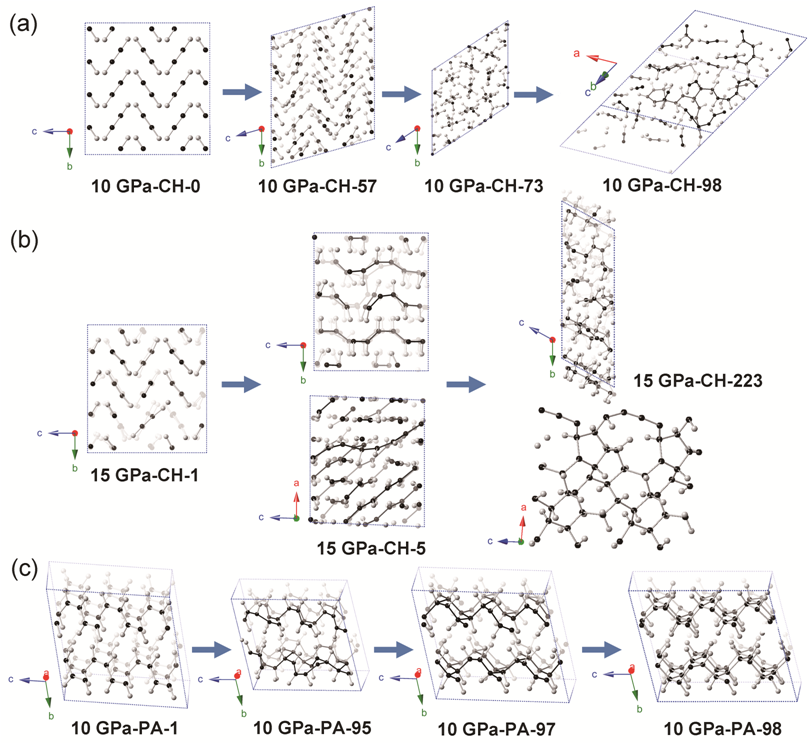A Possible Route from C2H2 to Graphane - Drs. Kuo Li and Haiyan Zheng
MAY 3, 2017
Scientists from HPSTAR, co-led by Drs. Kuo Li and Haiyan Zheng, have quantitatively explained the reaction route of polymerization of C2H2 under extreme condition by neutron diffraction and theoretical calculation. They discovered that under high pressure, acetylene molecules react along a specific crystallographic direction, which leads to the cis-polyacetylene. Following this route, the scientist discovered a potential method to synthesize graphane. By combing multiple methods, a layered polycyclic polymer was synthesized and identified as an intermediate between polyacetylene and graphane. This research provides a novel method of synthesizing carbon materialand the results are published in Angew. Chem. Int. Ed.(DOI: 10.1002/anie.201702685).
Acetylene (C2H2)is the simplest alkyne and can be used as building blocks for synthesizing largermolecules or materials like benzene and polyacetylene. It can polymerize under high pressure without any catalyst and generate polyacetylene (PA); where cis-PA is the preferred product especially when synthesized under low temperature. However, until now, its reactionprocess under high pressure and different pressure/temperature conditions have not been well understood.
By using in situ and ex situ experimental methods as well as theoretical calculations, the team systematically investigated the pressure-induced polymerization of C2H2, explaining the domination of cis-polyacetylene in the process. More surprisingly, they predicted graphane as the final product of this route and experimentally identified a layered polycyclic polymer that is an intermediate between polyacetylene and graphane.
Compared with a traditional chemical reaction, which is controlled by the temperature or a catalyst, the reaction rule under extreme conditions is still unknown even for very simple systems like C2H2. “A pressure-inducedreaction usually happens in the solid phase. Unlike the reaction in the gas or solutionphases, it follows a completely different path and is controlled by the crystalstructure, the orientations, and the distances of the molecules,” said Dr. KuoLi.
Graphanewas predicted for a long time but not stoichiometrically synthesized. However, high pressure provides a new method that may lead to new materials. “Usually, we synthesize material by tuning the temperature, chemical composition orcatalyst but pressure, as a thermodynamic variable, can also determine the compound stability and reaction. By manipulating the pressure, novel materials which cannot be obtained under ambient conditions can be yielded, such as the sp3carbon nanothread or Sn3Se4 etc.,” said Dr. Haiyan Zheng.

This investigation is a critical example of how to study reactions under extreme conditions. In situ neutron diffraction is more sensitive to light elements, and is thus a crucial tool for determining crystal structures right before polymerization. The reaction possibility is based on the intermolecular distance and molecular orientation experimentally but theoretical predictions are also very important. “Molecular dynamic simulation based on the experimentally obtained structure can help us to understand the reaction route and predict the product under high pressure,” said Dr. XiaoDong, the HPSTAR postdoc who lead the calculations.
Caption: Selected structure models of metadynamic simulations. (a) 10 GPa, (b) 15 GPa, and (c) 10 GPa from cis-polyacetylene theoretically predicted by pressure induced polymerization.
乙炔(C2H2)是最为简单的炔烃分子,众所周知,其在催化剂的作用下可以生成著名的导电高分子聚乙炔。压力也可以使乙炔发生聚合,常被作为高压反应的模型化合物,但是关于乙炔的聚合反应路径以及聚合产物,目前仍然知之甚少。北京高压科学研究中心的李阔和郑海燕研究员所带领的科研团队通过原位的中子衍射技术并结合分子动力学模拟系统的研究了极端条件下乙炔小分子的聚合反应过程,第一次获得了高压下聚合之前乙炔的精确晶体结构。在此基础上推断出了乙炔的聚合反应路径,第一次定量的解释了实验上所发现的顺式聚乙炔占优势的原因。并在此基础上,通过理论计算并结合红外光谱、固体核磁以及原子对分布函数证明了利用乙炔合成石墨烷的可能性。该研究为合成碳材料提供了新的思路,系统的证明了高压下的化学反应过程主要受分子取向及分子间距离的影响,并指出了利用低温结合高压技术合成晶态石墨烷的可能性。相关的研究成果“Pressure Induced Polymerization of Acetylene: Structure DirectedStereoselectivity and a Possible Route to Graphane”发表在近期的《德国应用化学》上 (DOI:10.1002/anie.201702685)。
